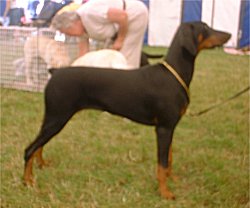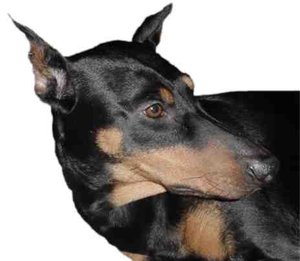Dobermann
|
|
| Dobermann | |||||||||||||||||||||
|---|---|---|---|---|---|---|---|---|---|---|---|---|---|---|---|---|---|---|---|---|---|
 Red Dobermann with uncropped ears and docked tail. | |||||||||||||||||||||
| Alternative names | |||||||||||||||||||||
| |||||||||||||||||||||
| Country of origin | |||||||||||||||||||||
| Germany | |||||||||||||||||||||
| Common nicknames | |||||||||||||||||||||
| Dobie | |||||||||||||||||||||
| Classification and breed standards | |||||||||||||||||||||
|
The Dobermann or Doberman Pinscher (also, more colloquially, Dobie) is a breed of domestic dog. Dobermanns are commonly used as guard dogs, watch dogs, or police dogs, and have a reputation as being a dog that is incredibly loyal to its familial duties and that is vicious if crossed.
| Contents |
Appearance
A female Dobermann's shoulder height is about 24 inches (61 cm) and weight is about 75 to 80 pounds (34 to 36 kg), whereas the male stands about 26 or 27 inches (66 to 68 cm) at the shoulder and weighs around 90 pounds (41 kg).
Color
Most people picture a Dobermann's color as the typical black with brown markings. However, the existence of two different color genes in Dobermanns provides four different phenotypes in Dobermann color. The traditional color, produced when both genes are dominant, is commonly referred to as black, while the most common variation, due to one gene's being recessive, produces what is called a red Dobermann, which is primarily reddish-brown with tan markings.
The other gene's being recessive, while the first one remains dominant, produces the blue (grey) Dobermann, whereas the least likely combination of both color genes' being recessive produces fawn, which is a light tan color, also sometimes called chocolate.
Recently, a fifth color of Dobermann, dubbed the white Dobermann, has been widely bred and marketed to the public. Dobermanns of this color possess a genetic mutation, which prevents its pigment proteins from being manufactured, regardless of the genotypes of either of the two color genes; that is, it is an albino. Though many potential Dobermann owners find the color beautiful, albino Dobermanns, like albinos of other species, face increased risk of cancer and other diseases and should avoid sun exposure as much as possible. The popularity of the white Dobermann has died down dramatically as the risks have become known, with many people even calling for an end to the breeding and marketing of the white Dobermann, because they perceive it as cruelty to the animal. Some countries have made the purposeful breeding of the white Dobermann illegal, though, as happens with human beings, random genetic mutation still leads to Dobermann albinism on a completely arbitrary, but very rare, basis.
Tails
What may come as a surprise to people who are used to seeing Dobermann tails that are just a couple of inches long, is that the Dobermann is actually born with a tail that is longer than that of most breeds of dog. Typically, a Doberman Pinscher undergoes docking, a procedure in which the majority of its tail is cut off within days after its birth. The rationale for this is that it is the "look" that the dog is supposed to have, since it was the way Louis Dobermann originally envisioned the dog. It also gives the dog an appearance of ferocity and toughness.
Aside from these more vain reasons of putting the animals through a procedure that many view as inhumane, one practical reason for docking the tail is that it removes what would be a convenient "handle" for a criminal or attacker to grab when the Dobermann is performing its guard or police work. Another reason is that dogs with the type of tails that the Dobermann has (long with little hair or flesh over the tail bones) have a very high occurrence of 'broken tail'. Broken tail may range from the actual tail bones being broken to the more common skin injuries that are very difficult to heal because of the difficulty of bandaging or protecting the tail. Broken tail is often a self inflicted injury caused by the Dobermann enthusiastically wagging its long tail, regardless of the objects it is hitting with it.
Regardless of people's beliefs on this matter, few Dobermann purchasers have a choice on the length of their Dobermann's tail; docking must be done soon after the dog's birth, which means that the breeder nearly always makes the decision, before their dogs are even put on the market.
Ears
This is not true, however, of Dobermann ear cropping, which should be done between 7 and 9 weeks, though it can done up to six months or a year after the Dobermann's birth, and is therefore usually left up to the discretion of the dog owner. Cropping done after 12 weeks has a high rate of failure in getting the ears to stand. In larger and larger numbers, Dobermann owners are opting not to have their pet's ears cropped, in a procedure that is believed to be extremely painful for the animal. The process involves cutting off part of the animal's ears and then propping them up with posts or cups and tape bandages, which allows the cartilage to develop into an upright position as the puppy grows. The puppy will still have the ability to lay the ears back or down. The process can take a few weeks or may take months. Because taping too tightly can cause blood flow problems, taping must be done by a veterinarian or experienced breeder.
While there have been no studies that involved looking at cropped vs non-cropped dobermans, it is believed that cropping dramatically reduces the occurrence of ear infections and hematomas (blood blisters caused by damage to the ear tips commonly from hard shaking of the head).
Although the acts of ear cropping and tail shortening seem inhumane to some, the traditional Dobermann has always been the one that has had both procedures. In some countries, docking and cropping are now illegal, but in some breed shows, particularly in the United States, Dobermanns are allowed to compete only if they have the traditional look.
Temperament
Because of the Dobermann's typical use as a guard dog, and its often stereotyped role as such in movies, many people are afraid of Dobermanns. However, Dobermanns are in general a loving and intelligent breed that rarely attacks people except when it feels that it, its property, or its family are in danger.
Health
An average, healthy Dobermann is expected to live around 12 years, with a majority of Dobermanns dying between age 11 and 13. Common health problems are Dialated Cardiomyopathy, von Willebrand's Disease (a bleeding disorder that can be tested for genetically), hypothyroidism, cancer and in the blues and fawns, alopecia.
History
Dobermanns were first bred in Germany around 1890 by Louis Dobermann. He was a tax collector who needed a protection dog to guard him, so he set out to breed a new type of dog that, in his opinion, would be the perfect combination of strength, loyalty, intelligence, and fierceness. Later, Otto Goeller and Philip Gruening continued to develop the breed.
The breed is believed to have been created from several different breeds of dogs that had the characteristics that Dobermann was looking for, including the Pinscher, the Rottweiler, the Thuringian Shepherd Dog, the black Greyhound, the Great Dane, the Weimaraner, the German Shorthaired Pointer, and the German Shepherd Dog. The exact ratios of mixing, and even the exact breeds that were used, remains uncertain to this day, although many experts believe that the Dobermann is a combination of at least four of these breeds. The single exception is the documented cross with the Greyhound. It is also widely believed that the German Shepherd gene pool was the single largest contributor to the Dobermann breed.
Dog Pictures and Clipart
- Pictures of Dogs (http://classroomclipart.com/cgi-bin/kids/imageFolio.cgi?direct=Animals/Dogs)
- Dog Clipart (http://classroomclipart.com/cgi-bin/kids/imageFolio.cgi?direct=Clipart/Animals/Dog_Clipart)
Clipart and Animal Pictures
- Clipart (https://classroomclipart.com/image/category/clipart.htm)
- Animal Clipart (https://classroomclipart.com/image/category/animal-clipart.htm)
- Animal Animated Clipart (https://classroomclipart.com/clipart/Animations/Animals.htm)
- Pictures of Animals (https://classroomclipart.com/image/category/animal-photos.htm)
- Amphibian Clip Art, Pictures and Photogaphs (https://classroomclipart.com/image/category/amphibian-clipart.htm)
- Farm Animal Clip Art, Pictures and Photographs (https://classroomclipart.com/image/category/farm-animal-clipart.htm)
- Mammal Clip Art, Pictures and Photographs (https://classroomclipart.com/image/category/mammal-clipart.htm)
- Marine Animal Clip Art, Pictures and Photographs (https://classroomclipart.com/image/category/marine-life-clipart.htm)
- Reptile Clip Art, Pictures and Photographs (https://classroomclipart.com/image/category/reptile-clipart.htm)
- Spider Clip Art, Pictures and Photographs (https://classroomclipart.com/image/category/spider-clipart.htm)



